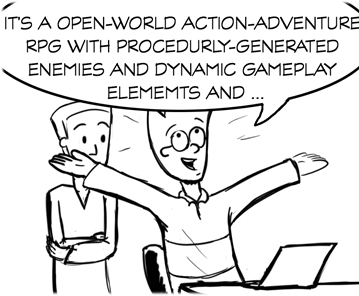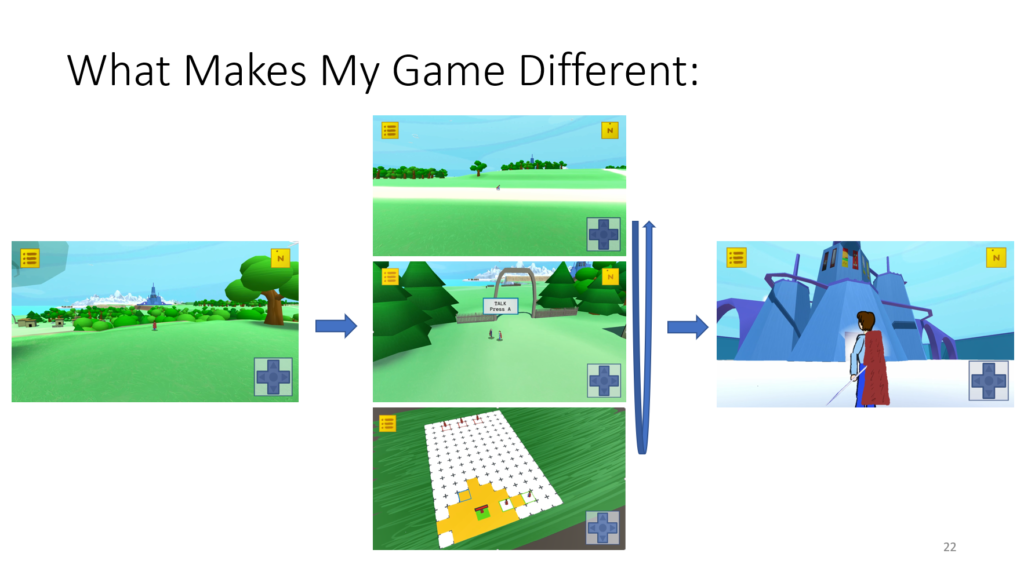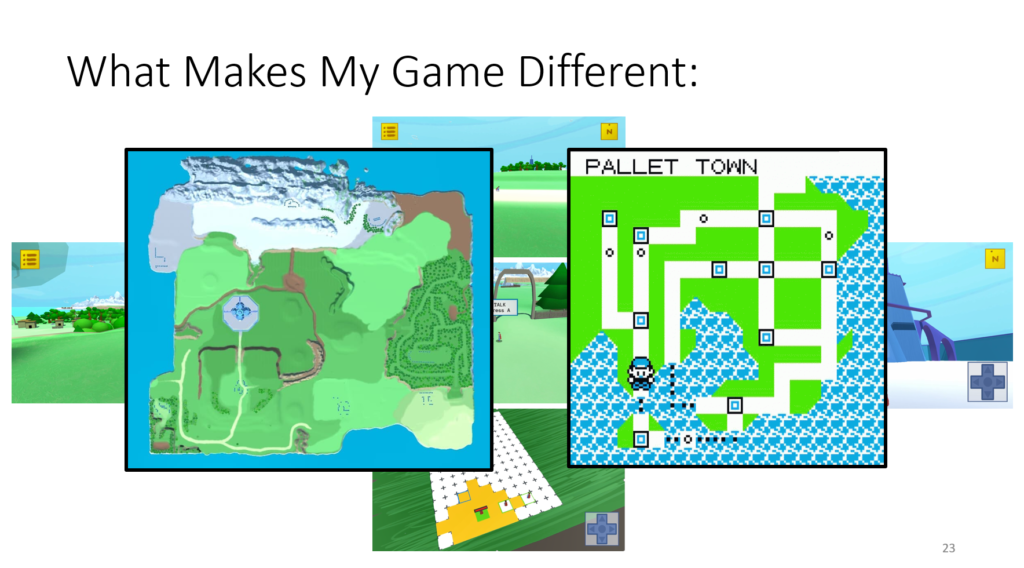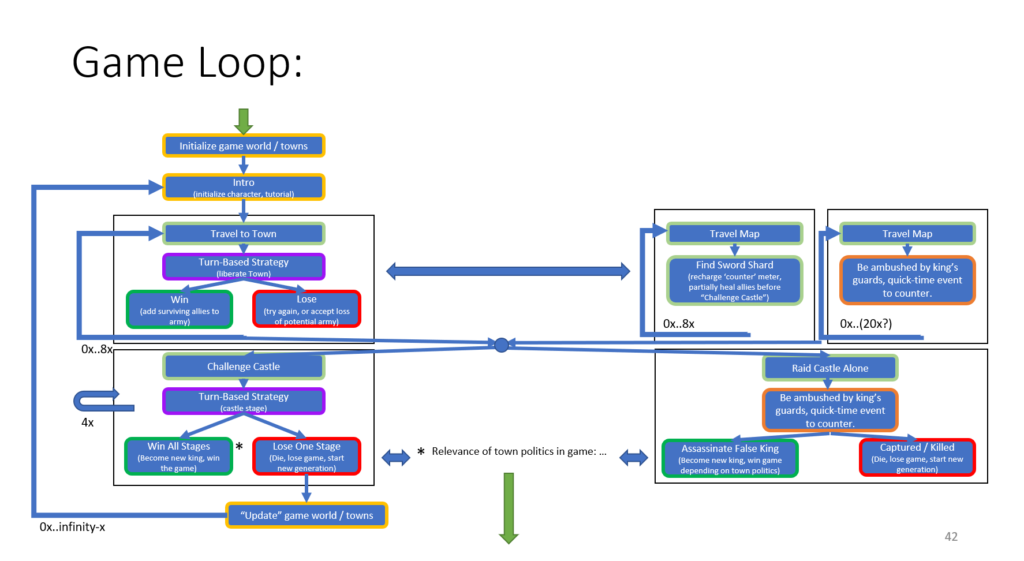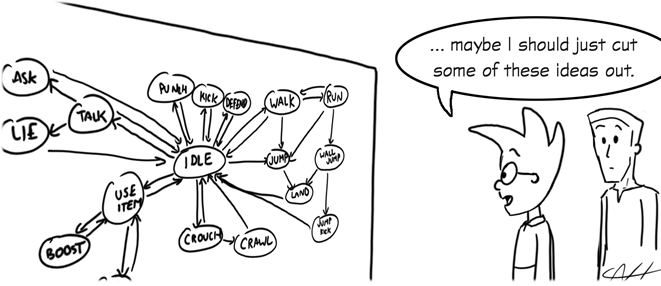Wow… almost 3 months without a blog post. That seems bad.
Actually, I’ve made some progress on my indie game development, and have been slowly showing parts of my progress at a local game dev meetup. And slowly, I’ll be posting that content here as well. I hope to have a lot more from “True King” in the near-coming months.
For now, let’s talk about the complex gameplay pitch. I haven’t really done that on this site all this time.
The concept for “True King” is this: on a dark night, the king and queen of a kingdom give birth to a child, the new heir to the throne. But immediately, the king’s advisor initiates a coup, killing the king and queen, and throwing the child in the nearby river. Becoming the king in their place, the advisor is a fair but ruthless leader, and the townspeople whisper about whether or not it is his place to be there. Years later, a person emerges from the lake on the edge of the valley. Not knowing who they are, rumors spread that this might be the lost child, the rightful heir.
Playing as this child (roughly appearing as a young adult now), you walk across the kingdom to each town, offering to “liberate” them by leading the townspeople in a turn-based strategy map. Those that survive each battle are retained: when you are ready, you can lead your new army to attack the castle at the center of the map. This is the most-basic gameplay loop: it’s a strategy game like “Fire Emblem,” or “Final Fantasy Tactics,” in a setting not too different from those, but with the addition of a REAL overworld, an open-world you can traverse in any order.
I haven’t seen any strategy games go to that length to make their games less linear, and I think it helps to break up the experience. And yes, the act of walking to each town was inspired loosely by the gameplay loop of the early “Pokémon” games.
But the gameplay document is much bigger than this, partially due to “feature creep” and partially due to my initial goals years ago. Partially a part of the game’s lore, you can lose the game: your character might die. If so, the game doesn’t end. Years will pass, and then yet another character will emerge from the lake. No one knows what the child really looked like, so it’s impossible to know if the character is the genuine heir or not. But you can still lead the people eager for a change as this curse repeats over and over. Alternatively, if your character does become king, the individual towns may decide you are not really the best suited monarch, due to your actions or the loss of units from each town. The curse might repeat yet again, forcing you to take back the castle from a past version of yourself!
To accomplish this, the towns need to evolve as time passes. The people grow, have children, and die. If you loose most of a town in battle, their town will shrink in size in the next generation. Otherwise, it will grow. Some people might migrate to other small towns, creating new offspring that have a mixture of stats. Their cultural ties and opinions are shaped partly by the heritage from their parents. Houses in each town will reflect this.
Is this complicated? Not necessarily. We’re just repeating the same gameplay loop multiple times over, adding some form of randomization and perpetuation when the town evolves to the next generation. This much has actually already been implemented (although some parts of the basic game loop, including cutscenes, has yet to be finished).
But even further… let’s add gameplay elements to make walking through the open world more interesting! Let’s add random guards that might attack you, with a countering quick-time event that gets progressively more difficult each time it occurs. Let’s add randomly places shards of the lost royal emblem to find, where collecting them will provide bonus stats, and make it more likely you will be accepted as the real heir. If the counter-ability exists, why not allow you to walk up to the castle and storm it yourself, defending yourself from guards one at a time, to assassinate the king single-handed, completely bypassing the strategy elements!
I presented all of this within a 5-minute pitch to a group of people. I showed this complex flow-chart. Naturally, reactions were mixed, and we all agreed that limiting the gameplay might make it more fun, if not at least easier to finish.
For now, I’ll hold off on the last paragraph (counter open-world enemies, collecting, and assassination) features. If I can finish and polish the rest, then maybe I’ll come back to it. In my mind, EVERYTHING is important for the gameplay experience, but those dreams never come out exactly right in reality anyway.
Tune in next time, when I’ll talk about improvements I’ve made to designing the game’s environment!

